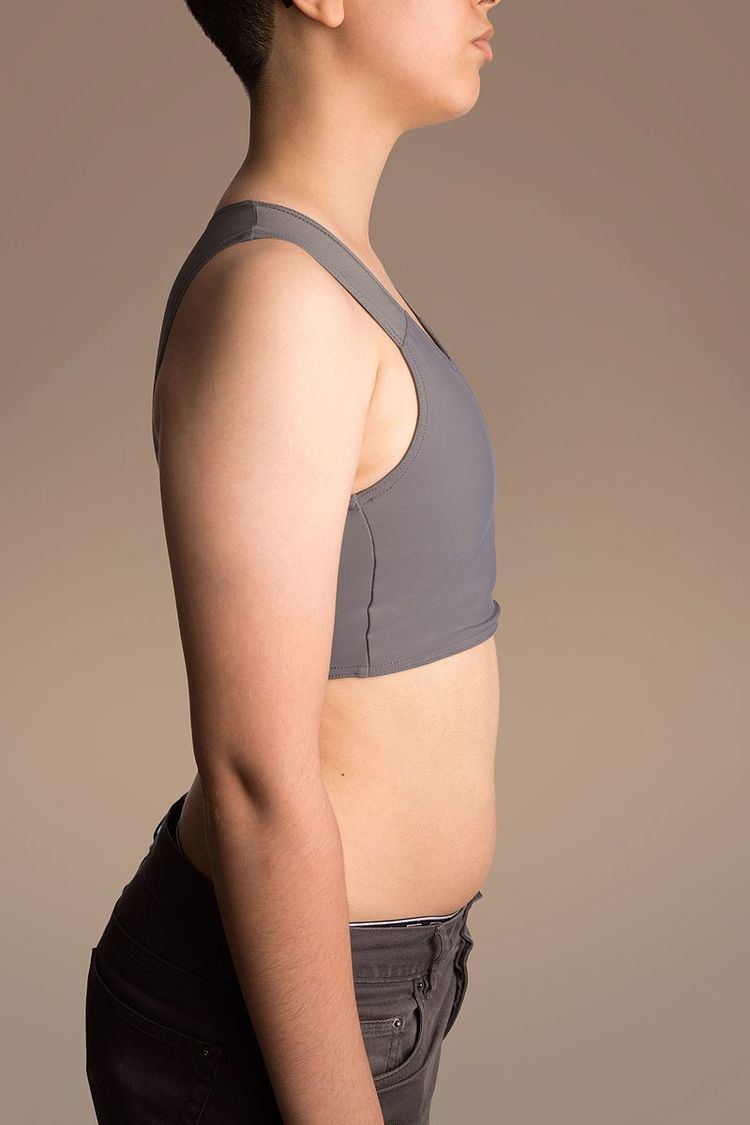 | ||
Breast binding is the act of flattening breasts by the use of constrictive materials. The term also refers to the material used in this act. Common binding materials include cloth strips, elastic or non-elastic bandages, purpose-built undergarments (often using Spandex or other synthetic fibre) and shirts layered from tight to loose. The act of breast binding is common for trans men, but is also done by androgynous and gender fluid people, as well as crossdressers and performers. Some women may use binders as alternatives to bras.
Contents
Breast binding by use of cloth strip or tape may result in bodily damage such as permanent deformation of the breast.
History
Different time periods of history have had differing viewpoints on the female form, including widespread use of corsets throughout western European history up to the Victorian era. The Japanese kimono can be considered a very elaborate form of binding, although the obi (belt) goes around the lower torso, the chest is bound by the sarashi. In the 1920s, flappers bound their chests to achieve a less traditional look. In addition, many Catholic nuns up until the 1930s were required to wear a linen breast binding under their garments in addition to their everyday vestments. This measure was designed to eliminate any potential distraction that the nuns' breasts might cause. In many ecclesiastical specialty shops, it is still possible to purchase antique linen breast bindings that have been hand-embroidered with crosses. Wearing a minimizer bra is common to help with large breasts.
Motivation
There are many reasons people would bind their breasts:
Some adolescent girls bind their breasts as they enter puberty. This is done usually for reasons of modesty (they do not want others to see them), embarrassment (they do not want others to know they have started developing), or desire to be as they previously were (they do not want to have breasts yet). This has potential risks, as the developing tissue may conform to the restricted shape, resulting in permanent deformity. Breast binding in adolescent girls may be a symptom of body dysmorphic disorder.
Cisgender men may also find cause to bind if afflicted with gynecomastia as a means to control appearance in place of surgery or during the wait before surgery. Transgender men, or people with non-binary gender identities, as well as women who have developed larger breasts from hormone replacement therapy or breast augmentation surgery, may have motivation to bind their breasts. Transgender men and people with other gender identities (typically male presenting) may bind their breasts as an alternative to or while waiting for a "top surgery" (mastectomy) in order to be recognized as masculine presenting.
Methods
There are many different methods of binding, but two cheap methods are wearing a sports bra or swimming suit top that is a few sizes too small underneath normal clothes. Two normal sports bras can be worn, with the second one worn backwards. Sports or compression bras can also be used by firmly pushing them against the chest, but these methods are unsafe.
Another way of binding is using a specially fitted binding bra, however these can be more expensive and are not widely stocked. There are places to buy binders, and they are a much better alternative to other, more dangerous methods.
Some people try to bind using an ace bandage or duct tape, however these methods are dangerous and may cause cracked ribs, trouble breathing, and even suffocation if worn to sleep.
However, excessive use of all binding methods can lead to back pain and breathing trouble. A binding device/method should always be as loose as is practical and should not be worn for longer than 8 hours.
Complications
Binding for extended periods of time can lead to rashes or yeast infections under the breasts. Unsafe binding may lead to permanent deformation of the breasts, scarring, and lung constriction and long-term binding may adversely affect the outcome of a future mastectomy.
